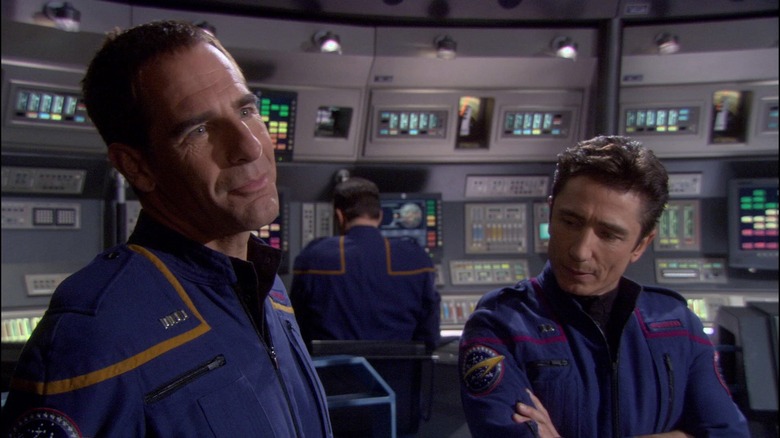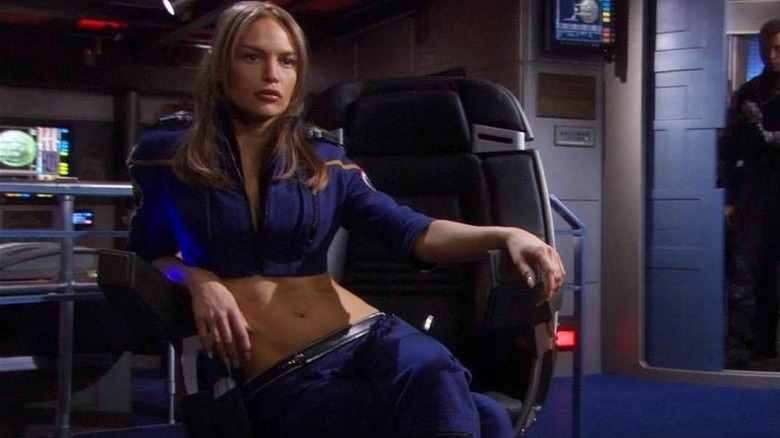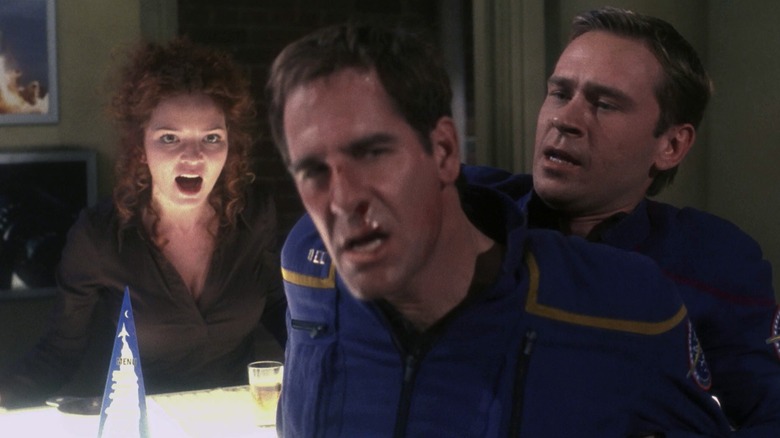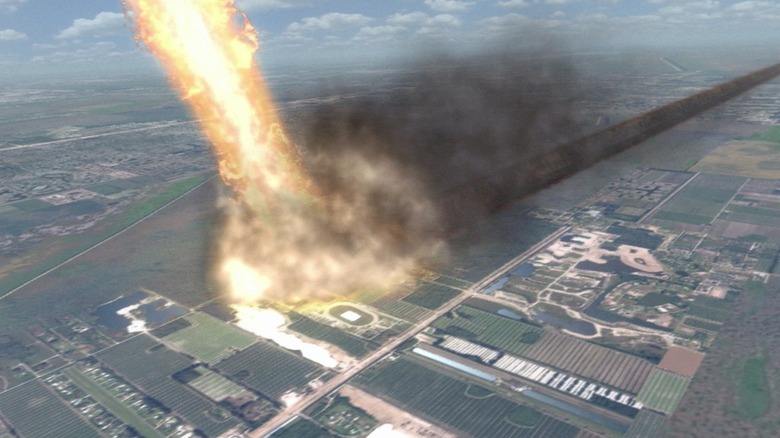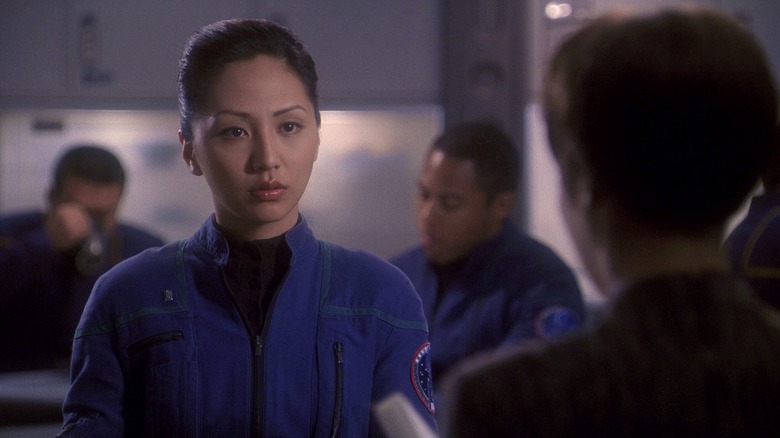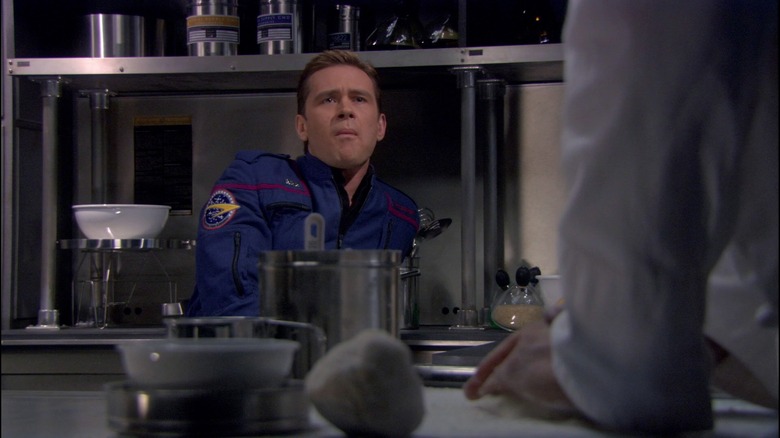5 Things Only Adults Notice In Star Trek: Enterprise
From its almost universally hated theme song to its bare-bones, submarine-inspired ship energy, "Star Trek: Enterprise" tells one of the most fundamentally different stories in the Trek canon. Long before Captain James T. Kirk (William Shatner) spread Federation ideals through the galaxy and Jean-Luc Picard (Patrick Stewart) welcomed diplomats aboard his Space Hilton, the prototypical Enterprise NX-01 brought pre-Federation humanity to the stars — and what a wild ride it was.
Originally airing on the UPN network during the early 2000s around the same time as "Buffy: The Vampire Slayer," "Enterprise" was part of a lineup that was meant to appeal to a fairly young demographic. For viewers who were still pretty young during the show's first run, rewatching from the business end of adulthood can be pretty eye-opening. From a storyline that's meant to parallel real-world events to steamy "Star Trek" scenes that would make even Q blush, here are five things only adults notice when watching "Enterprise."
1. It's the steamiest Star Trek series
Every Trek from "The Original Series" onward has its share of thirst traps from Kirk and William T. Riker's (Jonathan Frakes) horny space diplomacy to the generous use of Dabo girl skin at Quark's bar. But "Enterprise" is a master class in sculpting a plot around lust-inducing eye candy.
While a millennial-era teenager might not have fully realized how gratuitously sexual "Enterprise" is, the salacious undertone can almost feel cringe-inducing at times when viewed through adult eyes. And nowhere is this more obvious than the ship's decon chamber, where the ship's hottest crewmates get to oil each other up while hanging out in their space undies after each mission.
One of the show's most unabashedly thirsty scenes is in "Xindi," when T'Pol (Jolene Blalock) strips away her top while directing Trip Tucker (Connor Trinneer) in the art of Vulcan neuropressure. "You can apply considerable pressure," she directs him while cupping her nacelles for modesty's sake. "Harder...harder...just like that," before gasping and then directing him to "Please disrobe" so she can return the favor. And then there's that moment in "Shockwave" when a sweaty Hoshi Sato (Linda Park) loses her shirt while jumping down from an air vent. "In a Mirror, Darkly" brings things to its logical conclusion by pairing some of the franchise's most revealing crop tops with unnecessary girl fights and a steady stream of racy dialogue.
2. Archer is incredibly unprofessional
Captain Jonathan Archer's (Scott Bakula) personality throughout "Enterprise" serves as a constant reminder of how far Starfleet progresses as the decades and centuries pass. In contrast with the refined professionalism of later captains like Kathryn Janeway (Kate Mulgrew), Benjamin Sisko (Avery Brooks), and Picard, Archer is fairly rough around the edges — which makes sense since he's literally writing the book on what it means to be a Starfleet leader. But a few rewatches in, his frequently unprofessional behavior can seem almost out of control at times, and it's hard to imagine Archer would make it far in the Picard-era Federation.
Rudeness, temperamental behavior, and an overall lack of respect for alien cultures are some of the hallmarks of Archer's early command. This serious lack of professionalism can be seen in the pilot episode "Broken Bow" as Archer appears before Starfleet Command and the Vulcan Council. When he is told the Vulcans want to delay the Enterprise launch, Archer immediately becomes disrespectful, mouthing off to the Klingons and his superiors before entering a medical treatment area without asking. When T'Pol calls humanity "volatile," he responds by telling her he wants to knock her out.
In "A Night in Sickbay," Archer angrily complains to members of his crew about having to "grovel" after offending the Kreetassians. He then negligently lets his dog Porthos urinate on the Kreetassan planet, leading to an interplanetary diplomatic crisis Archer stubbornly refuses to take responsibility for until he's forced to.
3. The Xindi storyline is meant to parallel 9/11
"Star Trek: Enterprise" aired just two weeks after the World Trade Center attack on September 11, 2001. Although younger audiences might not have caught it, the show's Xindi storyline drew heavy inspiration from this real-world terrorist act and its global impact. Beginning in the Season 2 finale, the Xindi storyline begins with a seemingly unprovoked devastating attack on the Earth from a previously unknown alien species ("The Expanse"). During the attack, an alien probe appears above the planet to carve out a 4,000-kilometer path of destruction running from Florida to Venezuela, killing 7 million victims and leaving the world stunned and horrified.
As Starfleet grapples with the fallout, Archer and his crew soon discover the attack was perpetrated by the Xindi, a race of aliens made up of five distinct species. It's later revealed that the attack was just a test run for a larger weapon meant to destroy the Earth ("Azati Prime"). Veteran Trek producer/director David Livingston confirmed the familiar story origin on the Season 3 video commentary, noting, "The Xindi were destroying parts of Earth. So, it was reflective of what was going on at the time." On Bob Saget's "Here For You" podcast, Scott Bakula later added, "Of course, our series was colored by 9/11 happening. We were shooting then and that eventually took over the direction of our show in terms of mirroring that event and casting it into the studio and painting it with the StarTrek brush."
4. The show recycles a lot of other Trek stories
Watch "Star Trek" long enough, and you might eventually start to realize that some of the plots feel awfully familiar. In a franchise with hundreds of episodes, it should hardly come as a surprise that tried-and-true sci-fi tropes keep showing up across Starfleet eras. But one of the more common criticisms of "Enterprise" is its writers' alleged overreliance on sliced, diced, but ultimately rehashed plots from other "Star Trek" series. Whether intentional or coincidental, many of the NX-01's adventures do seem to mirror other stories in the franchise pretty closely.
"Oasis," which starred eventual Borg Queen Annie Wersching and René Auberjonois (Odo on "Star Trek: Deep Space Nine"), finds the Enterprise crew exploring a supposedly haunted ship populated by hologram-generated illusions. The plot so closely resembled the "Deep Space Nine" episode "Shadowplay" that Auberjonois mentioned it to Bakula while on set.
The episode "Dawn," which found Trip Tucker stranded with an alien he could not communicate with, is like a Wish.com copy of "The Next Generation" episode "Darmok," which in turn borrows heavily from the film "Enemy Mine." And "Vanishing Point," which features a terrified Hoshi believing that she's dematerializing after a transporter accident, is like a darker take on "The Next Generation" episode "The Next Phase." "Terra Nova" resembles the "Voyager" episode "Friendship One," and "Precious Cargo" marks the third use of "The Original Series" plot from "Elaan of Troyius," which showed up in the "Next Generation" episode "The Perfect Mate."
5. It has more character development than most Star Trek series
"Star Trek: Enterprise" might be something of an intergalactic hot mess — particularly in Season 1 when writers didn't seem to know what to do with some characters. But when taken as a whole, many fans have noticed this series presents some of the best character development in the "Star Trek" franchise. Nowhere is this more evident than with Archer, who grows from something of an anti-Vulcanist bigot with little respect for the serious historical implications of the crew's every interaction to a fully-formed diplomat with a commitment to creating a brighter future for humanity.
At the beginning of the show, T'Pol appears to be a stereotypical Vulcan — she seems to have little interest in being more than the Enterprise's space babysitter and frequently expresses a repressed disdain for humanity's food, habits, and even smells. As the series progresses, we see her grow, face personal demons, and form powerful friendships, particularly with Hoshi, Archer, and Trip. By the end, T'Pol has blossomed into a voice for interspecies cooperation who has come to deeply value her human counterparts.
Hoshi begins "Enterprise" as a brilliant linguist who is afraid of everything and struggles with severe anxiety. While aboard the Enterprise, she learns to rely on those around her for guidance and support and actively works on managing and overcoming her own mental health hurdles. Likewise, Trip matures both in his professional growth and his relationships with other characters, particularly with T'Pol, as seen when he puts her feelings before his own when faced with her arranged marriage to Koss ("Home"). Despite the show's rocky start, the crew's personal growth helps make "Enterprise" one of the most powerful character-driven stories in the "Star Trek" canon.
